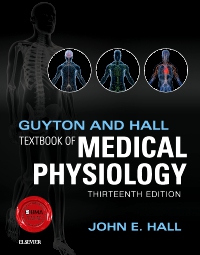
Guyton and Hall Textbook of Medical Physiology Elsevier eBook on VitalSource, 13th Edition
Elsevier eBook on VitalSource

Newer Edition Available
Guyton and Hall Textbook of Medical Physiology Elsevier eBook on VitalSource
-
- Larger font size emphasizes core information around how the body must maintain homeostasis in order to remain healthy, while supporting information and examples are detailed in smaller font and highlighted in pale blue.
- Summary figures and tables help you quickly convey key processes covered in the text.
- Brand-new quick-reference chart of normal lab values on the inside back cover.
- Increased number of figures, clinical correlations, and cellular and molecular mechanisms important for clinical medicine.
- Instructor resources including PowerPoint slides, image bank, and test banks are available through your Elsevier sales representative or at Evolve.Elsevier.com.
-
- Brand-new quick-reference chart of normal lab values on the inside back cover.
- Increased number of figures, clinical correlations, and cellular and molecular mechanisms important for clinical medicine.
- Student Consult eBook version included with purchase. This enhanced eBook experience includes the complete text, interactive figures, references, plus 50 self-assessment questions and more than a dozen animations.
-
I. Introduction to Physiology: The Cell and General Physiology
1. Functional Organization of the Human Body and Control of the "Internal Environment"
2. The Cell and Its Functions
3. Genetic Control of Protein Synthesis, cell function, and cell reproduction
II. Membrane Physiology, Nerve, and Muscle
4. Transport of Substances Through Cell Membranes
5. Membrane Potentials and Action Potentials
6. Contraction of Skeletal Muscle
7. Excitation of Skeletal Muscle: Neuromuscular Transmission and Excitation-Contraction Coupling
8. Excitation and Contraction of Smooth Muscle
III. The Heart
9. Cardiac Muscle; The Heart as a Pump and Function of the Heart Valves
10. Rhythmical Excitation of the Heart
11. The Normal Electrocardiogram
12. Electrocardiographic Interpretation of Cardiac Muscle and Coronary Blood Flow Abnormalities: Vectorial Analysis
13.Cardiac Arrhythmias and Their Electrocardiographic Interpretation
IV. The Circulation
14. Overview of the Circulation; Biophysics of Pressure, Flow, and Resistance
15. Vascular Distensibility and Functions of the Arterial and Venous Systems
16. The Microcirculation and Lymphatic System: Capillary Fluid Exchange, Interstitial Fluid, and Lymph Flow
17. Local and Humoral Control of Tissue Blood Flow
18. Nervous Regulation of the Circulation and Rapid Control of Arterial Pressure
19. Role of the Kidneys in Long-Term Control of Arterial Pressure and in Hypertension: The Integrated System for Aterial Pressure Regulation
20. Cardiac Output, Venous Return, and Their Regulation
21. Muscle Blood Flow and Cardiac Output During Exercise; the Coronary Circulation and Ischemic Heart Disease
22. Cardiac Failure
23. Heart Valves and Heart Sounds; Valvular and Congenital Heart Defects
24. Circulatory Shock and Its Treatment
V. The Body Fluids and Kidneys
25. The Body Fluid Compartments: Extracellular and Intracellular Fluids; Edema
26. The Urinary System: Functional Anatomy and Urine Formation by the Kidneys
27. Glomerular Filtration, Renal Blood Flow, and Their Control
28. Renal Tubular Reabsorption and Secretion
29. Urine Concentration and Dilution; Regulation of Extracellular Fluid Osmolarity and Sodium Concentration
30. Renal Regulation of Potassium, Calcium, Phosphate, and Magnesium; Integration of Renal Mechanisms for Control of Blood Volume and Extracellular Fluid Volume
31. Acid-Base Regulation
32. Diuretics, Kidney Diseases
VI. Blood Cells, Immunity, and Blood Coagulation
33. Red Blood Cells, Anemia, and Polycythemia
34. Resistance of the Body to Infection: I. Leukocytes, Granulocytes, the Monocyte-Macrophage System, and Inflammation
35. Resistance of the Body to Infection: II. Immunity and Allergy
36. Blood Types; Transfusion; Tissue and Organ Transplantation
37. Hemostasis and Blood Coagulation
VII. Respiration
38. Pulmonary Ventilation
39. Pulmonary Circulation, Pulmonary Edema, Pleural Fluid
40. Principles of Gas Exchange; Diffusion of Oxygen and Carbon Dioxide Through the Respiratory Membrane
41. Transport of Oxygen and Carbon Dioxide in Blood and Tissue Fluids
42. Regulation of Respiration
43. Respiratory Insufficiency - Pathophysiology, Diagnosis, Oxygen Therapy
VIII. Aviation, Space, and Deep-Sea Diving Physiology
44. Aviation, High Altitude, and Space Physiology
45. Physiology of Deep-Sea Diving and Other Hyperbaric Conditions
IV. The Nervous System: A. General Principles and Sensory Physiology
46. Organization of the Nervous System, Basic Functions of Synapses, and Neurotransmitters
47. Sensory Receptors, Neuronal Circuits for Processing Information
48. Somatic Sensations: I. General Organization, the Tactile and Position Senses
49. Somatic sensations: II. Pain, Headache, and Thermal Sensations
X. The Nervous System: B. The Special Senses
50. The Eye: I. Optics of Vision
51. The Eye: II. Receptor and Neural Function of the Retina
52. The Eye: III. Central Neurophysiology of Vision
53. The Sense of Hearing
54. The Chemical Senses - Taste and Smell
XI. The Nervous System: C. Motor and Integrative Neurophysiology
55. Motor Functions of the Spinal Cord; the Cord Reflexes
56. Cortical and Brain Stem Control of Motor Function
57. Contributions of the Cerebellum and Basal Ganglia to Overall Motor Control
58. Cerebral Cortex, Intellectual Functions of the Brain, Learning, and Memory
59. Behavioral and Motivational Mechanisms of the Brain - The Limbic System and the Hypothalamus
60. States of Brain Activity - Sleep, Brain Waves, Epilepsy, Psychoses, and Dementia
61. The Autonomic Nervous System and the Adrenal Medulla
62. Cerebral Blood Flow, Cerebrospinal Fluid, and Brain Metabolism
XII. Gastrointestinal Physiology
63. General Principles of Gastrointestinal Function - Motility, Nervous Control, and Blood Circulation
64. Propulsion and Mixing of Food in the Alimentary Tract
65. Secretory Functions of the Alimentary Tract
66. Digestion and Absorption in the Gastrointestinal Tract
67. Physiology of Gastrointestinal Disorders
XIII. Metabolism and Temperature Regulation
68. Metabolism of Carbohydrates and Formation of Adenosine Triphosphate
69. Lipid Metabolism
70. Protein Metabolism
71. The Liver as an Organ
72. Dietary Balances; Regulation of Feeding; Obesity and Starvation; Vitamins and Minerals
73. Energetics and Metabolic Rate
74. Body Temperature Regulation and Fever
XIV. Endocrinology and Reproduction
75. Introduction to Endocrinology
76. Pituitary Hormones and Their Control by the Hypothalamus
77. Thyroid Metabolic Hormones
78. Adenocortical Hormones
79. Insulin, Glucagon, and Diabetes Mellitus
80. Parathyroid Hormone, Calcitonin, Calcium and Phosphate Metabolism, Vitamin D, Bone, and Teeth
